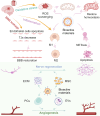Bioactive Materials Facilitate the Restoration of Neurological Function Post Cerebral Ischemic Stroke
- PMID: 39764188
- PMCID: PMC11701096
- DOI: 10.2147/IJN.S493987
Bioactive Materials Facilitate the Restoration of Neurological Function Post Cerebral Ischemic Stroke
Abstract
The recovery process following ischemic stroke is a complex undertaking involving intricate cellular and molecular interactions. Cellular dysfunction or aberrant pathways can lead to complications such as brain edema, hemorrhagic transformation, and glial scar hyperplasia, hindering angiogenesis and nerve regeneration. These abnormalities may contribute to long-term disability post-stroke, imposing significant burdens on both families and society. Current clinical interventions primarily focus on endovascular therapy, overlooking the protection of brain cells themselves. However, the use of bioactive materials in stroke management has shown notable safety and efficacy. By precisely targeting the ischemic site at a cellular and molecular level, this therapeutic approach mitigates ischemia-induced brain tissue damage and promotes site repair. This review examines the protective benefits of bioactive materials in reducing cell damage and facilitating nerve restoration in accordance with the pathophysiological basis of ischemic stroke. Enhanced understanding of ischemic stroke mechanisms has the potential to advance the targeted and efficient clinical use of bioactive materials.
Keywords: angiogenesis; bioactive materials; inflammation; ischemic stroke; nerve regeneration; oxidative stress.
© 2024 Wang et al.
Conflict of interest statement
The authors report no conflicts of interest in this work.
Figures







Similar articles
-
Neuroprotective Mechanisms of Baicalin in Ischemia Stroke.ACS Chem Neurosci. 2025 Jun 4;16(11):1978-1995. doi: 10.1021/acschemneuro.4c00842. Epub 2025 May 22. ACS Chem Neurosci. 2025. PMID: 40402033 Review.
-
Trillium tschonoskii rhizomes' saponins induces oligodendrogenesis and axonal reorganization for ischemic stroke recovery in rats.J Ethnopharmacol. 2021 Oct 28;279:114358. doi: 10.1016/j.jep.2021.114358. Epub 2021 Jun 21. J Ethnopharmacol. 2021. PMID: 34166736
-
Valproic Acid Inhibits Glial Scar Formation after Ischemic Stroke.Pharmacology. 2022;107(5-6):263-280. doi: 10.1159/000514951. Epub 2022 Mar 22. Pharmacology. 2022. PMID: 35316816
-
Bifunctional Nanostarch against Neuronal Apoptosis via Mitochondria Protection for Ameliorating Ischemic Stroke Injury and Promoting Long-Term Neurological Recovery.ACS Appl Bio Mater. 2025 May 19;8(5):3833-3844. doi: 10.1021/acsabm.4c02005. Epub 2025 Apr 27. ACS Appl Bio Mater. 2025. PMID: 40289357
-
Therapeutic targets of neuroprotection and neurorestoration in ischemic stroke: Applications for natural compounds from medicinal herbs.Biomed Pharmacother. 2022 Apr;148:112719. doi: 10.1016/j.biopha.2022.112719. Epub 2022 Feb 12. Biomed Pharmacother. 2022. PMID: 35168073 Review.
Cited by
-
Knockdown of RUNX2 Attenuated A1 Astrocyte Overactivation, Brain Injury, and Cerebral Edema During Ischemic Stroke.Neuromolecular Med. 2025 Jun 27;27(1):48. doi: 10.1007/s12017-025-08868-8. Neuromolecular Med. 2025. PMID: 40576866
-
Therapeutic Potential of Sea Cucumber-Derived Bioactives in the Prevention and Management of Brain-Related Disorders: A Comprehensive Review.Mar Drugs. 2025 Jul 30;23(8):310. doi: 10.3390/md23080310. Mar Drugs. 2025. PMID: 40863627 Free PMC article. Review.
References
Publication types
MeSH terms
Substances
LinkOut - more resources
Full Text Sources
Medical

